Better than the 2012.
Part I appears here.
Moving from the 2012 MacBook Air to the 2013 involves no learning curve. Ergonomically the machines are identical.
If you are moving from an earlier model, before wiping it clean for sale do remember to deactivate iTunes (limit is 5 activations) and Photoshop (limit is 2 activations). For iTunes it’s in the Store menu option, for PS it’s under Help.
As usual, I migrated applications and data using Migration Assistant, a speedy and seamless process.
In terms of start-up speed, meaning a working display after opening the lid (there’s no need to ever power the machine off) it’s very noticeable that start-up is considerably faster. The occasional 2-5 second wait (it’s not consistent) with the 2012 is gone, the screen lighting up either instantaneously or 1 second after opening. Apple mentioned this in their roll-out and it appears to be true, not their usual hype. Nice.
Some test data:
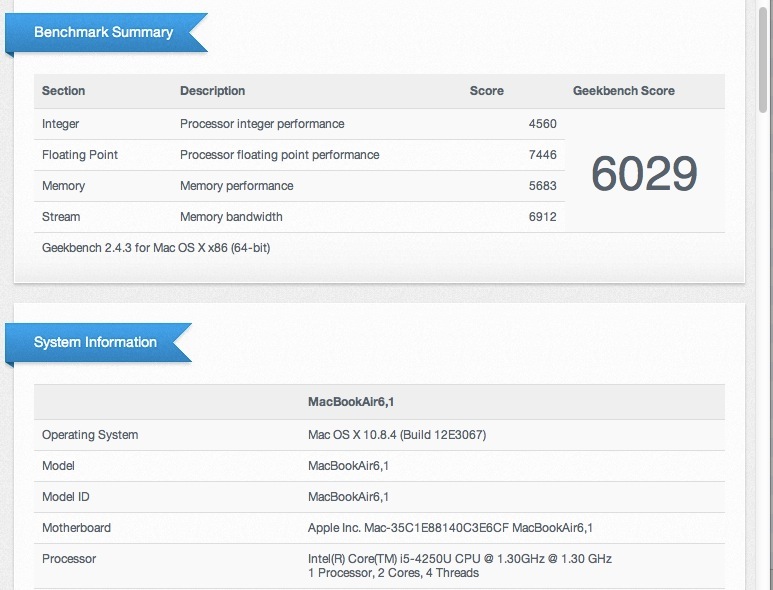
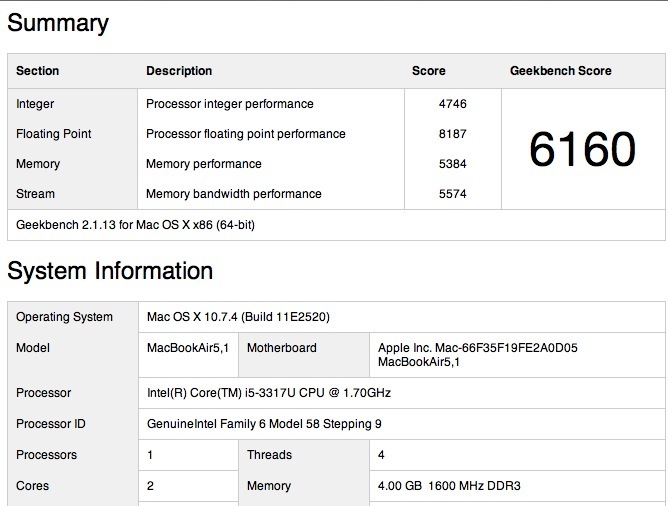
MBA 2013 and 2012, Geekbench 64.
The 2013 CPU is marginally slower but you do not notice this in practice.
Graphics, as measured by Cinebench, are far faster, thanks to the new HD5000 integrated GPU in the 2013 model; the 2012 uses the HD4000 CPU, integrated with the Ivy Bridge CPU:
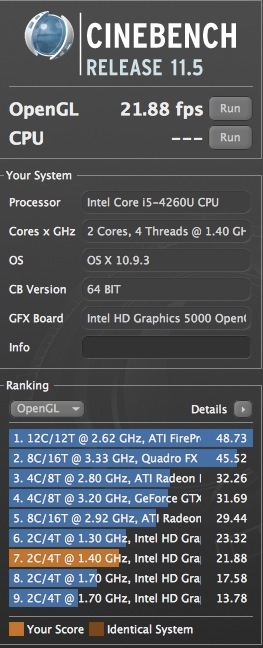
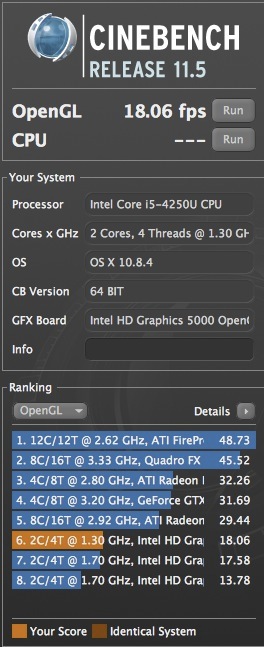
Cinebench 2013 and 2012. The 2013 is 31% faster.
Temperature Monitor (from Bresink) is not yet updated and cannot graphically display the Haswell CPU’s core temperatures, though it does display all the other sensors. SMC Fan control, however, does report the CPU temperature in the status bar. The CPU in the 2013 runs 10-20F cooler than in the 2012, rarely hitting 140F. 158F in the 2012 was common. These machines run hot, owing to poor cooling in the limited space available, the upshot being you can feel the warmth on your lap with stressful processes – like Cinebench. The new machine is noticeably cooler. As usual I’m running SMC Fan Control with a minimum setting for the one poncy fan of 3,500rpm. It’s not audible in practice. The stock speed is just too low for comfort and I rather prefer my vitals unfried.
I don’t have tools to objectively measure the key upgrade in the 2013, meaning battery life, but after a day’s use I can confirm my earlier estimate that the 4 hour life in the 11″ model has approximately doubled, owing to the lower power consumption Haswell CPU. Impressive.
My 2013 MBA has the minimum 4GB of RAM and a 128GB SSD. The Lightroom (Version 5) and Photoshop (CS 5.1) experience remains excellent and no excuses need be made for the MBA 2013 as a photo processing machine. LR starts in 7 seconds, PS in 3-4. Exporting an image from LR to PS takes a scant 2 seconds. Add an external larger display and you have a fine photo processing machine.
The new faster 802-11ac wifi is present, but I have no means of testing this as my router does not support it, so I’m running 802-11n at 5GHz from an ancient single band Airport Extreme router.
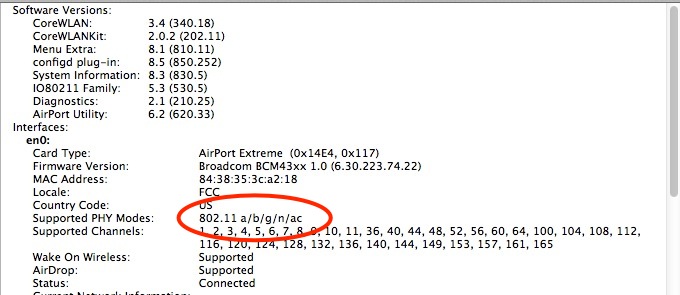
802-11ac installed.
Scrolling in the 2012 model using two fingers on the the touchpad is excellent; in the 2013 it’s not as good, showing slight jerkiness owing to response delay. I’m confident this is something Apple will fix in an OS or firmware upgrade.
Sequential disk access (both machines use a Solid State 128GB drive) is 38% faster, measured with xbench:
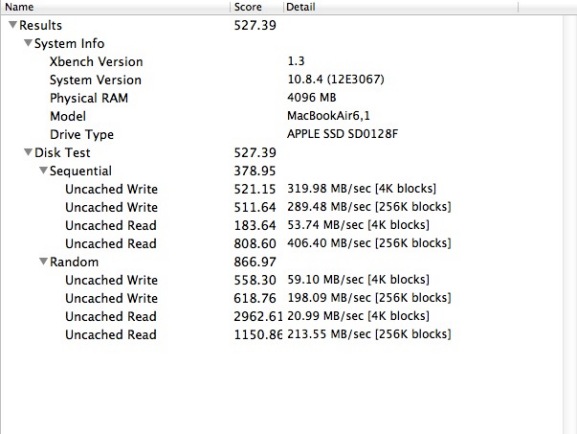
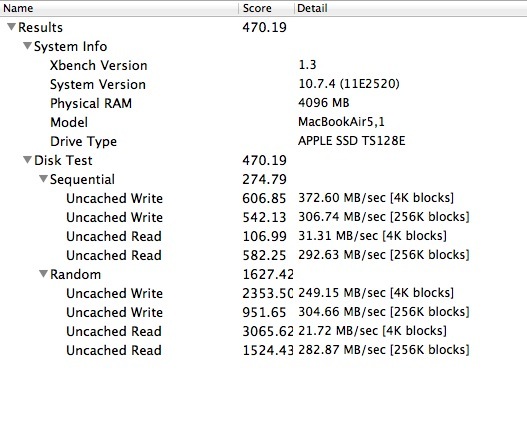
2013 and 2012 disk access data.
I suspect the speed increase results from the use of a PCI connection for the SSD in the 2013 machine, compared to SATA3 in the 2012 version. Strangely random disk access is far slower in the newer machine but I have not seen any subjective slowdown. SSDs are nice for fast starts from cold (irrelevant here) and application loading, but if high volume storage is required with a MacBook Air then an external Thunderbolt (costly and very fast) or USB3 (cheap but slower) traditional hard disk drive is called for. Thuderbolt enclosures seem to start at $500+, a price point which will ensure they do not gain mass market acceptance. USB3 enclosures, like the Mediasonics I use for movie storage, run $100 for a 4-bay box. However, neither of my two Mediasonic boxes is seen by the 2013 MBA, whereas the 2012 was fine, so it looks like Mediasonic will have to issue a firmware upgrade. USB2 works fine with both, and both have the latest circuit boards.
The perpendicular Magsafe2 power connector continues over from the 2012. This is most certainly not an improvement on the right-angled MagSafe1 used in the 2010 model which had a far stronger magnet. The current connector is dislodged far too easily, but Apple has refused to listen to its users, not for the first time.
There is one small error in Mountain Lion on this machine. If you have multiple apps open and quit one, the menu bar disappears until any other app is clicked. Probably an error in the kernel which, I assume, has been modified to work with the new Haswell CPU. Not a big deal.
There’s really not much more to say. For $1,000 with a high resale value, the cost of ownership is low, the machine is as light and robust as can be, and is arguably the best bang for the buck in any laptop currently on the market. Resale value one year hence will be around $700, making the annual cost of ownership just $300.
The Good:
- Runs cooler and faster than the 2012 model
- $100 cheaper than the 2012
- Very well made and robust given how slim it is
- Doubled battery life compared with the 2012 model
- Fast 128GB SSD
- Excellent Intel HD5000 graphics processor
- Retina Display is not missed in an 11″ screen
- Wake from sleep is much quicker than in 2012
- No Windows OS. Masochists can run Windows using Boot Camp or aftermarket software
- Decent speakers for its small size
- Full sized, backlit keyboard
- Fine machine for Lightroom and Photoshop, though plugging in a larger display really helps
- Familiar mechanical design has shown no major weak points over the past few years
- Excellent resale value. Compare with any Windows laptop
The Bad:
- Wretchedly weak magnet on the Magsafe2 power plug
- Two finger touchpad scrolling is noticeably jerky. 2012 model was perfect in this regard **
- Status bar at top of screen disappears when an application is exited
- SDXC card reader available on the 13″ model only
- You will have to buy two – one for your spouse
** I tracked down the cause of this. On my 3 display desktop I use an app named Mouse Locator which throws up a big green circle where the cursor last was if you ‘lose’ it. That app migrated over to my MBA years ago when I migrated all my apps over from the big machine. Disabling this app (in System Preferences) and restarting made the jerkiness go away. The app is not required on the MBA’s small screen so no loss.